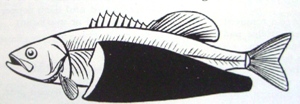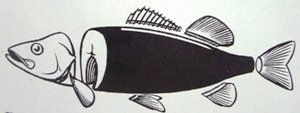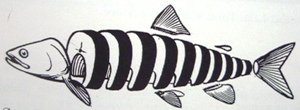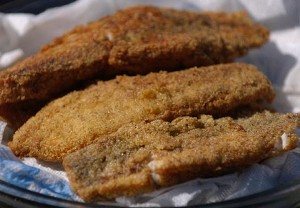|
 How
to Cook Fish How
to Cook Fish
Cooking Lean
One of the secrets to cooking Florida fish is to make allowances for the
fat content. In other words, lean fish may be cooked by dry heat methods
such as baking or broiling, if you baste frequently with melted butter
or shortening to prevent drying (Try combing lemon or garlic with the
basting fat, or using a basting sauce.) Fish with high fat content don't
have to be basted.
It's also important not to overcook fish.
It should be moist and tender with a delicate flavor. Overcooking causes
the fish to become increasingly dry and chewy. You can tell the fish is
done when the flesh is translucent and can be easily flaked with a fork.
Three
Basic Cuts of Fish

Filleted
Sides of fish are cut lengthwise along
backbone.

Dressed, or pan-dressed
Scaled, drawn with head, tail and fins
removed.

Steaked
Cross-sectional slices are cut from larger
fish.
Fish
Chowder
In a deep pan, fry until crisp 3 or 4
slices of chopped bacon. Add 1 or 2 onions, 2 cups of sliced potatoes, 1
teaspoon salt, and 4 cups of water. Bring to a boil and simmer for 10 to
15 minutes. When the potatoes are nearly soft, put in about 2 pounds of
cubed fillets with bones removed. Cook fish until tender, about 15
minutes; add 4 cups evaporated milk. (Or use powdered milk pre-mixed in
water and reduce water used to boil potatoes.) Add a generous chunk of
butter, bring just to a boil and simmer until hot throughout. Salt and
pepper to taste.
|

Campfire Cooking
Baking With Foil
An easy way of cooking Florida fish is
by using aluminum foil and charcoal or propane. Lay the fillet on a
sheet of heavy foil making sure the backbone does not poke a hole.
People top their fish with everything from salad oil and mayonnaise to
simple think-sliced potatoes and butter. Experiment!
Frying
A simple cooking method is to fry fish in
a heavy cast iron skillet. clean the fish, wipe nearly dry, then flour
with corn meal, pancake mix, or packaged biscuit mix. Flour fish by
shaking it in a paper sack. If a batter of eggs and milk is used, dip
fish in cracker or bread crumbs. Use oil, shortening, or butter about a
quarter inch deep in skillet, preheating until hot, but not smoking, or
until a bit of bread browns, quickly. As soon as the fish browns on one
side, turn it over. when it flakes with a fork, remove from the skillet
and drain on a paper towel.
Cooking Your Fish At Home
Broiling
Sprinkle serving-sized portions of fish
with salt and pepper. Place on preheated greased broiler pan, skin side
up if skin has not been removed from fillets. Brush with melted butter.
Broil about 2 inches from heat 5 to 8 minutes, or until fish flakes
easily with a fork.
Baking
Rub cleaned fish inside and out with salt;
place in a greased baking pan. Brush with melted fat (lay slices of
bacon over top if desired). Bake in a moderate oven till fish flakes
easily with a fork. If fish seems dry while baking, baste with
drippings.
Steaming
Salt cleaned fish on both sides. Place
fish in a well-greased steamer pan and cook over boiling water till fish
flakes easily with a fork. Serve at once with lemon or sauce.
Deep Fat Frying
Sprinkle serving-sized portion of fish
with salt and pepper. Dip fish in a mixture of 1 tablespoon milt to 1
egg. Roll in bread or cracker crumbs, cornmeal, or flour. cook fish in
deep fat (375°) till golden brown. Drain on absorbent paper. Serve with
lemon or sauce.
|

 How
to Cook Fish
How
to Cook Fish